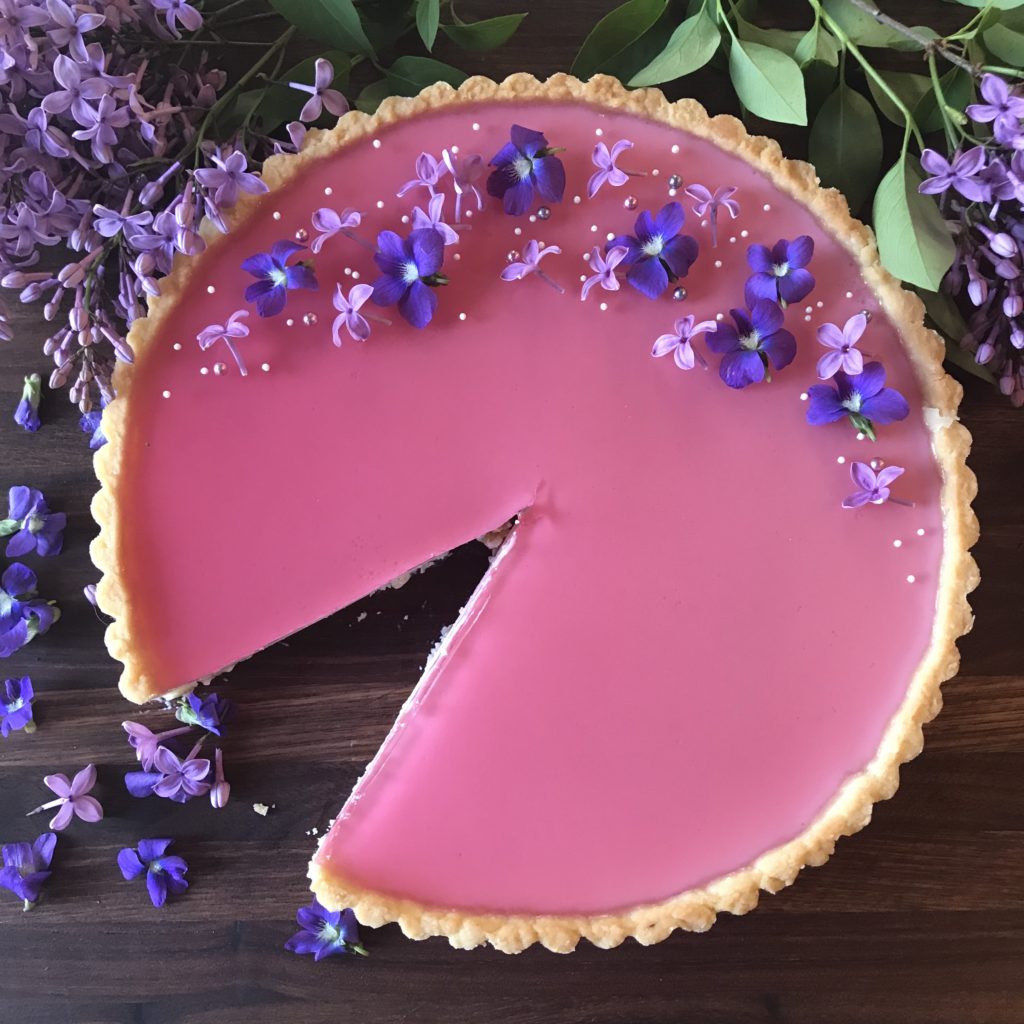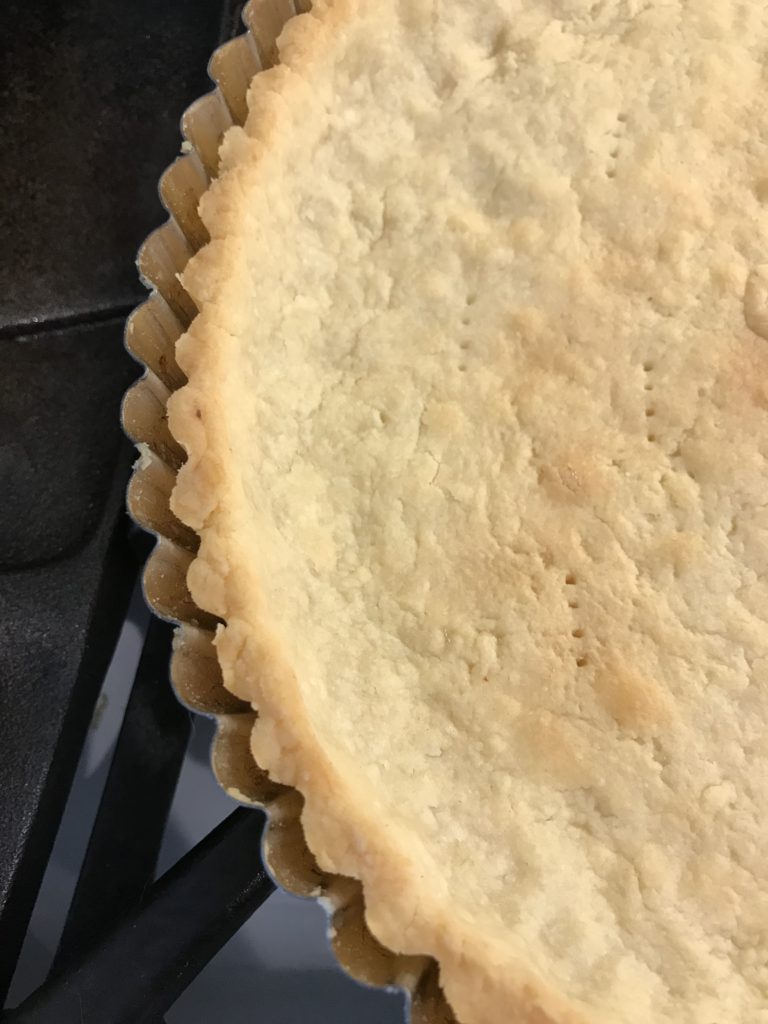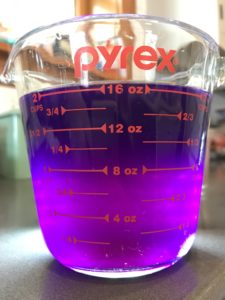Every year I make violet jelly just like my mom taught me when I was a girl. But because the season is so brief and the color of the violet tea is so divine, I’m always looking to make something new and different with the foraged flowers. Last year it was Violet Lemonade, the year before that was Violet and Elderflower Gummies.

This year I got the idea that I’d like to make a tart with violets, but then I thought maybe I’d make some panna cotta with a violet jelly on top. Ultimately I decided to do both! This gorgeous Lilac and Violet Panna Cotta Tart was a labor of love. Lots of experimentation and thinking and thinking some more. But now you get to reap the benefits of my mental labor! The result is a buttery, flaky crust with creamy, rose-scented panna cotta topped with a slightly tart jelly made from an infusion of lilacs and violets. It’s not too sweet, very floral and the essence of spring.

The Crust

Deciding which crust to use was the first hurdle. Panna cotta is very moist and has to be poured when it is very thin, so you want to use a crust that is somewhat water resistant and forms a good seal. Normally I would use a shortbread crust for something like this but It would have been way too heavy and sturdy for this tart. A standard pie crust with an egg white wash would have been lovely but I have a strange mental block about traditional pie crust. All the warnings about keeping the ingredients extra cold and cutting in the butter still intimidate me. So I decided to use this french pastry dough recipe from David Lebovitz. It is an interesting recipe that directs you to put all the ingredients minus the flour in a heat-proof bowl in a 410 degree oven until the butter is bubbling and beginning to brown. Then you dump the flour into the sputtering butter mixture, stir into a ball and dump into your tart pan. When it’s cool enough to handle, you press it into the pan and bake. No pie weights, no blind bake, no egg wash. And the resulting pastry is so buttery and flaky. The only trick about this dough is that in the past it has been very prone to cracking so it’s important to reserve a grape-sized piece of raw dough so you can patch any cracks that appear after baking or before you fill it. If that sounds too fiddly for you and you have another tart crust you prefer, I say go for it! Honestly, this dessert is all about the pan cotta and jelly, the crust just needs to be functional.

The Panna Cotta
The panna cotta is super straightforward. It’s basically like making jello with milk and cream. The rosewater gives the whole thing a nice floral flavor and the optional rose-colored food dye lets your eyes know to expect something special. Be sure to bloom the gelatin in the cold milk and be sure not to boil the milk mixture. Just hot enough to dissolve the gelatin and sugar is just right. To make sure you don’e end up with a soggy mess, put the completely cooled crust in the freezer for five minutes then pour just enough of the panna cotta in to cover the bottom of the tart and return it to the freezer. This thin layer will set up quickly before it has a chance to get soggy, then you can pour the rest of the panna cotta and that first layer will protect the base from all that moisture.

The Lilac and Violet Jelly
This is the only bit that was a little fiddly. You have a few things working against you when trying to make a jelly that retains the violet color. The gelatin, heat and acid have to be just right for this to stay brilliant pink/violet but still set up properly. I made 4 batches trying to get it right. The most important thing is to make the “tea” ahead of time. This means gathering your flowers and pouring boiling water over them and letting them steep for 4-24 hours. The more flowers and the longer they steep the more brilliant the color will be. Do not add the sugar until after you’ve made the tea. The sugar fixes the pigment in the violet petals and you won’t get any color to your tea. For this you can choose any proportion of violet and lilac flowers. The lilac give it flavor and fragrance and the violets give it color. You can use all lilac flowers and add violet food dye or use all violet flowers and add some rosewater or orange blossom water. This is about celebrating the first flowers of spring, it’s not necessary to be a purist here. Do whatever makes your heart happy!
The amount of lemon is important here. If you use too much it will interfere with the gelatin. You want to add just a tablespoon to change the color, then bloom the gelatin in the violet tea before adding the sugar and heating to dissolve. If you are feeling nervous about it setting, like I was, you can put a few tablespoons into a cup and refrigerate for 10 minutes and see if it sets. If so, go ahead and pour. If not, add a bit more gelatin, rewarm and try again. The most magical thing about this jelly is the color from the violets. It glows with an amethyst purple that is almost prettier than the flower itself. And it makes a nice science demonstration.


When you pour the boiling water over the petals, the liquid turns a dark sapphire blue. The first time I made it I thought I had done something wrong. But when you add the lemon juice, the citric acid reacts to the cyan-compounds and lowers the pH, turning it right back to purple! It’s pretty neat. The flavor is very mild. It’s mostly just sweet.
Collecting Your Flowers

- Try to gather on a dry day. Muddy flowers mean muddy jelly. Ew.
- Which leads me to my next tip, which is to gather flowers in an area you feel confident is not loaded with pesticides and dog pee.
- Make sure to get as many flowers into your pint jar as you can. Press them down gently to fit them all in. The more flowers, the deeper the color.
- Make your violet tea as soon as you can after picking, while the petals are still a nice and fresh. A few hours is fine.

More Wild Edible Treats From Bakers Brigade:

| Servings |
|
- 6 tablespoons butter cut into pieces
- 1 tablespoon vegetable oil
- 3 tablespoons water
- 1 tablespoon sugar
- pinch salt
- 1 rounded cup all-purpose flour
- 1 cup Whole milk
- 2 teaspoons powdered gelatin I used Knox
- 2 tablespoons sugar superfine, if you have it
- 1 cup heavy cream
- 1/4 teaspoon rosewater or to taste
- 1/2 teaspoon vanilla extract
- pinch salt
- 1 drop rose-colored food dye optional, I use Americolor Dusty Rose
- 1/2 cup lilac and violet flowers packed in, not crushed
- 1 cup boiling water
- 1 tablespoon lemon juice
- 1 tablespoon sugar
- 1 1/2 teaspoons gelatine
- 1/8 teaspoon rosewater optional
- lilac blossoms, violet blossoms and sprinkles for decorating, optional
Ingredients
For Crust:
For Panna Cotta:
For Lilac-Violet Jelly
|

|
- Preheat oven to 410 degrees. Place all the ingredients except for the flour in a heatproof bowl. Bake for 15 minutes, or until the butter is bubbling and starting to brown at the edges. Carefully take the butter mixture out of the oven and dump in the flour. Use caution, as it will definitely sputter. Stir until it forms not a ball and pulls away from the sides of the bowl. Dump into a tart pan with a removable bottom and spread it a bit with a spatula.
- Once the dough is cool enough to handle, press it into the bottom and sides of the pan. Be sure to set aside a grape-sized piece of raw dough in case you need to patch any cracks while baking and filling. Bake the crust for 15 minutes, or until pale golden brown.
- Remove from oven and cool completely. If there are any cracks fill them with a bit of dough right while the crust is still hot.
- Put the cold milk in a medium saucepan and sprinkle the gelatin over the top. Let it bloom for 5 minutes. turn the heat on low, and cook milk for a few minutes until the gelatin is dissolved. Do not let the milk get hot. Add the sugar and heat over low until it's dissolved, do not let it boil or simmer.
- Remove the pan from the heat and add the cream, rosewater, vanilla, salt and optional food dye and mix until combined.
- Place tart crust in freezer for 5 minutes. Then pour just enough of the milk mixture to cover the bottom with a thin layer. Place back in freezer for 10 minutes. Then pour the rest of the mixture into the tart. Refrigerate for two hours until set.
- Place flowers in a heatproof jar and cover with boiling water. Let sit for 4-24 hours. Strain in a colander lined with a paper towel, squeezing the flowers to get all the color out. Stir in the lemon juice. Then stir in the sugar.
- Sprinkle gelatin over the flower tea and let it bloom for 5 minutes. Heat over low heat, stirring until gelatin and sugar have dissolved. Gently pour over tart and refrigerate until set, about an hour. If you want to test the mixture, you can pour a small amount into a cup first and refrigerate for 10 minutes to make sure it sets up correctly.
- Decorate with flowers and sprinkles if desired.

The photos are lovely, but I can’t find the size of the tart pan.